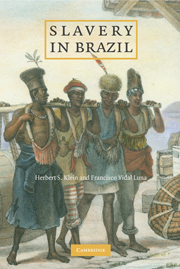7 - Slave Resistance and Rebellion
Published online by Cambridge University Press: 05 June 2012
Summary
The growth of a sense of identity and community among Afro-Brazilian slaves was essential for their survival as a society and group. Families were established, children were educated, and beliefs were developed that gave legitimacy to their lives. Yet much of their lives were controlled by others. Their labor was defined by others and was not typically organized by households, as in the case of all other working-class persons. Even their social behavior was restricted by whites when it clashed with the needs for control or the norms of behavior found acceptable by whites. Physical violence was also inherent in chattel slavery and created a level of fear and uncertainty unmatched by any other form of class or labor relations in America. Finally, even the physical well-being of the slave and his or her family was at the whim of his or her master and could be affected by considerations outside the slave's control.
Thus, no matter how adjusted their culture and community might make them feel toward the Brazilian society in which they found themselves, slaves always felt a degree of dependency and loss of control that created basic uncertainty and hostility toward the whole system. For those who were unable to conform, incapable of restraining their individuality, or unlucky enough to find themselves with no autonomy or protection within the system, resistance, escape, and rebellion were the only viable alternatives.
- Type
- Chapter
- Information
- Slavery in Brazil , pp. 189 - 211Publisher: Cambridge University PressPrint publication year: 2009



